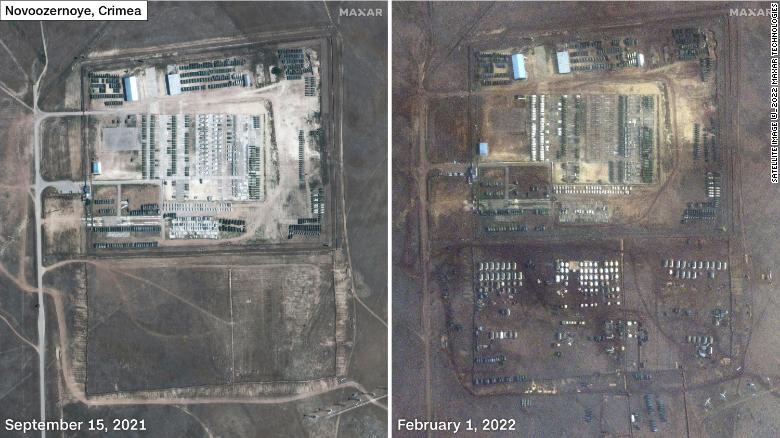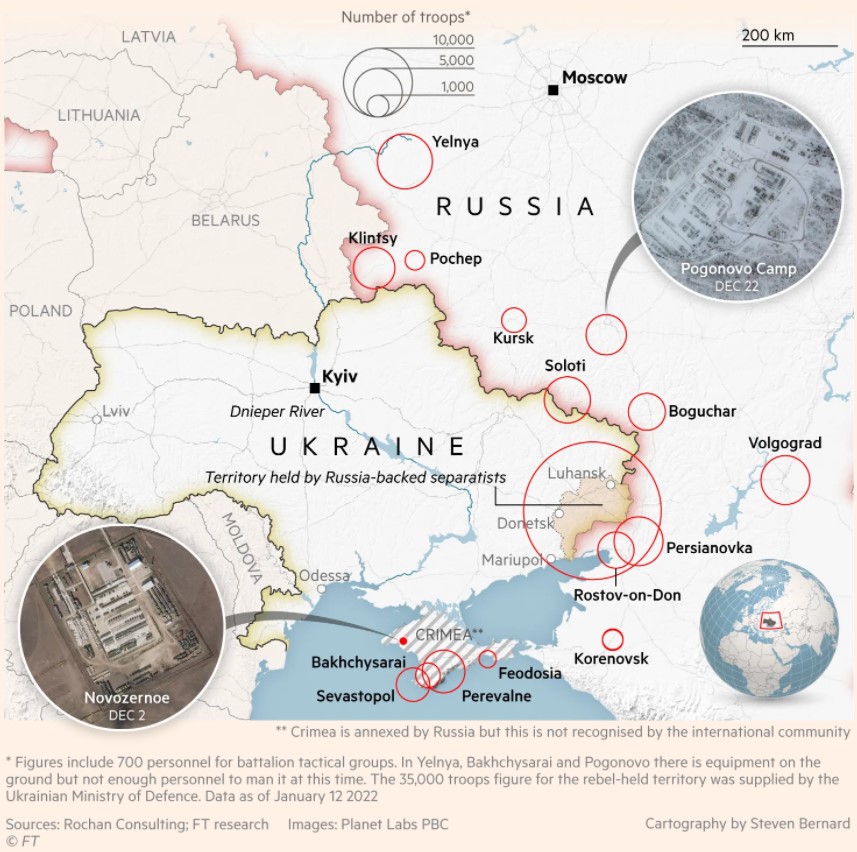Ever since late 2021, United States (US) Intelligence reports have shown that as many as 100,000 Russian troops have gathered near the Russo-Ukraine borders.
Tensions continued to mount as Ukraine Military’s latest intelligence assessment showed that there was an addition of 27,000 Russian troops building up, with 21,000 air and sea personnel moving Iskander operational-tactical missiles closer to the borders.
By all accounts, the threat of the Kremlin invading Ukraine appeared very real, which shocked the North Atlantic Treaty Organisation (NATO) and put the US into high alert, in fear of Russian aggression.
Is it possible that the world will be seeing a second cold war—a battle of ideologies and national security interests—with Ukraine at the eye of the storm?
The White House Sends 3,000 Extra Troops to Eastern Europe
Ever since the Russian military has been building up throughout January, the US hasn’t stayed idle as it placed 8,500 troops based in its domestic borders on heightened alert in case they needed to mobilise for a NATO Response Call.
Besides that, Commander-in-Chief and President Joe Biden has officially approved the deployment of 3,000 US troops to Poland, Germany, and Romania.
These additional US troops were signed off at the White House during a Tuesday morning meeting with Defence Secretary Lloyd Austin and Joint Chiefs Chairman General Mark Miller.
1,700 troops from the 82nd Airborne Division infantry brigade combat team based at Fort Bragg, North Carolina, will be dispatched to Poland.

300 service members from the 18th Airborne Corps from Fort Bragg will be deployed to Germany, whilst a stryker squadron already based in Germany will be moving into Romania.
Pentagon Press Secretary John Kirby stated that this series of manoeuvres were purely in defence and emphasised that “These forces are not going to fight in Ukraine”.
For all intents and purposes, the newly deployed troops are meant to be temporary, at least until Russian aggression recedes.
The Impetus Behind the Increased Deployments
In a brief exchange with CNN’s Kaitlan Collins in the White House East Room, Biden said: “[The decision] is totally consistent with what I told Putin in the beginning. As long as he’s acting aggressively, we’re going to make sure we reassure our NATO allies and Eastern Europe we’re here and Article V is a sacred obligation.”
The North Atlantic Treaty Organisation (NATO) was initially established in 1949 with the founding principle of fending against the Soviet Union’s aggression.
In Article V of NATO’s treaty is dedicated to collective defence at its very heart; if a NATO Ally is a victim of an armed attack, each and every other member of the Alliance will consider this act of violence as a threat against all members, and will take actions it deems necessary to assist the Ally attack, including the deployment of troops.
However, in the eyes of Russia, the continuous deployments are only worsening the tensions present in Europe.
Kremlin spokesman Dmitry Peskov told CNN’s Matthew Chance in an exclusive statement on Wednesday (2 Feb) that the deployments are the “best proof” that Russia has an evident reason to be worried about its own national security.
Join our Telegram channel for more entertaining and informative articles at https://t.me/goodyfeedsg or download the Goody Feed app here: https://goodyfeed.com/app/
NATO Allies Welcome the Reinforcement
To the nations involved—Poland, Germany, and Romania—the inclusion of US troops in their defensive ranks is a welcomed one.
Polish Foreign Minister Zbigniew Rau has already planned to visit the White House today (4 Feb) and the Secretary of State Antony Blinken for further discussions about sending more US troops into the country.
The Eastern Flank of Europe is currently under the command of the French, which consists of a 3,500-strong Franco-German brigade at its core.
The NATO Secretary-General, Jens Stoltenberg, approves of the US deployment and claimed that the alliance as a whole can take similar steps to bolster its eastern flank.
While NATO, the White House, Kremlin, and Kyiv are no longer calling the Russian invasion as something “imminent”, because the term holds connotations that it is about to happen, the escalating tensions have yet to show signs of exploding with the constant diplomatic talks ongoing in the background.
However, new satellite imagery have revealed that the military presence at Belarus, Crimea and western Russia are increasing further.
For instance, when Maxar compared images of a military camp in Novoozernye, Crimea in September and February, there was a marked increase in activity with tents being set up.

Likewise, in the Pogonovo training area in Voronezh, western Russia, the enlarging presence of tanks, artillery, and tents could be perceived.

Hence, NATO allies are understandably wary of the possible threats closing in on their borders, and having the US uphold their end of the sacred obligation in times of need to act as deterrence to another superpower, is a welcome relief.
Demands From Both Sides
Ultimately, the conflict boils down to a few reasons, judging from the correspondences between the various parties involved:
- The US does not wish for Ukraine’s sovereignty to be infringed upon
- Both NATO and the US demand for the pull-back of Russian troops from the borders
- The Kremlin has consistently expounded on their security interests by:
– Demanding that Ukraine is forever barred from joining NATO
– The US deployments still present in Eastern Europe after the end of the Cold War be rolled back
It should come as no surprise that points two and three have already been rejected by both sides.
In one of the leaked correspondences disclosed by a Spanish newspaper El Pais, Washington and Moscow have been talking and came to an agreement that both sides should refrain from stationing offensive missiles in Ukraine.
For once, it seemed like the lessons taught in history have been avoided.
Washington also wrote that there were no cruise missiles in either Poland or Romania, while trying to avoid any dangerous incidents in air or at sea.
In response to the leak, US State Department spokesperson Ned Price said: “I have seen nothing to suggest that those documents are not authentic. What we have conveyed… are proposals for further diplomatic engagement. This will require engagement in good faith. Some concerted fairly technical discussions, if they are going to result in anything.”
History Repeating Itself?
As previously analysed in the simplified version of the Russo-Ukraine conflict that stretches back to 2014, although the tensions are soaring with every revelation of troop additions, there are also active steps being taken in the background to prevent an outright war.
In fact, the entire conflict is oddly reminiscent of the Cuban Missile Crisis in 1962, wherein both sides were militaristically prepared for war, but were reluctant to fire the starting pistol.
Their concerns had been similar too:
- The Soviet Union did not want US interference in Cuba
- Khrushchev, then-dictator of the USSR, wanted the US-installed missiles discovered in Turkey that threatened its country by close proximity dismantled
- Likewise, Washington wanted the Cuban-Soviet SS-4 medium-range ballistic missiles that were 90 miles away from US shores removed
For Russia, both conflicts were ultimately used as a bargaining chip to guarantee its own national security interests.
Even though Russia shares borders with Estonia, Latvia, Belarus, and Ukraine, only Ukraine is viewed as a potential risk of becoming a frontline in a war against Russia, if one were to ever break out.
Estonia and Latvia were previous Soviet Union states, but they are many times smaller than Ukraine, which is rich in population and resources by comparison. The Kremlin putting up little to no protest regarding the two countries’ admittance into NATO and the European Union (EU) is proof of that.
Meanwhile, Belarus is a strong ally of Russia as they are joined together in an organisation called the Union State of Russia and Belarus.
As it stands, Russia’s consistent interference with Ukraine, whether it is in its elections, economic reform processes, or forming closer ties with the EU and by extension the Western powers, is because Russia wants Ukraine to remain as a “grey zone” or a buffer country.

Whereas for the US, it has always been wary of Russia, even after the end of the Cold War which broke down the entire battle of ideologies of Capitalism versus Communism.
Its motivation for wanting Ukraine to have closer ties with the rest of Western Europe and to strengthen itself internally is because Ukraine is the first line of defence against any Russian aggression or its desires for territorial expansion.
Nevertheless, relations are becoming more strained, and the military presence at the borders are only intensifying
The Current Diplomatic State of Things
Diplomatic talks between the European countries, the US, and Russia are still ongoing.
On Tuesday (1 Feb), United Kingdom’s Prime Minister Boris Johnson accused the Kremlin of holding “Ukraine’s head at gunpoint”, to which Putin replied that NATO was not adequately responding to Russia’s security concerns, and even went as far as calling Johnson “utterly confused”.
Regardless of caustic insults thrown in the political arena, Britain has sworn to send extra support to their Baltic allies.
Meanwhile, French President Emmanuel Macron said he would have more discussions with US President Biden and perhaps forward it with a trilateral meeting with Russian President Putin.
German Chancellor Olaf Scholz also mentioned that he would be meeting with President Putin, but no specific dates were given.
Only time and history will tell the outcomes of this newest conflict, but it definitely won’t be as short-lived as the Cuban Missile Crisis which only took 13 days to resolve.
Read Also:
- Judge Ordered Wife to Give Her Husband $400 in Monthly Maintenance As He Can’t Work
- Family of Woman Who Died in Tour Bus in M’sia to Get $650k in Compensation
- Ho Ching Joins a Global Investment Firm as Board Member
Featured Image: Shutterstock / Stefano Garau
Would you be jailed for being half-naked in public? Well, the answer will shock you. Seriously. Watch this to the end and you'll understand:




